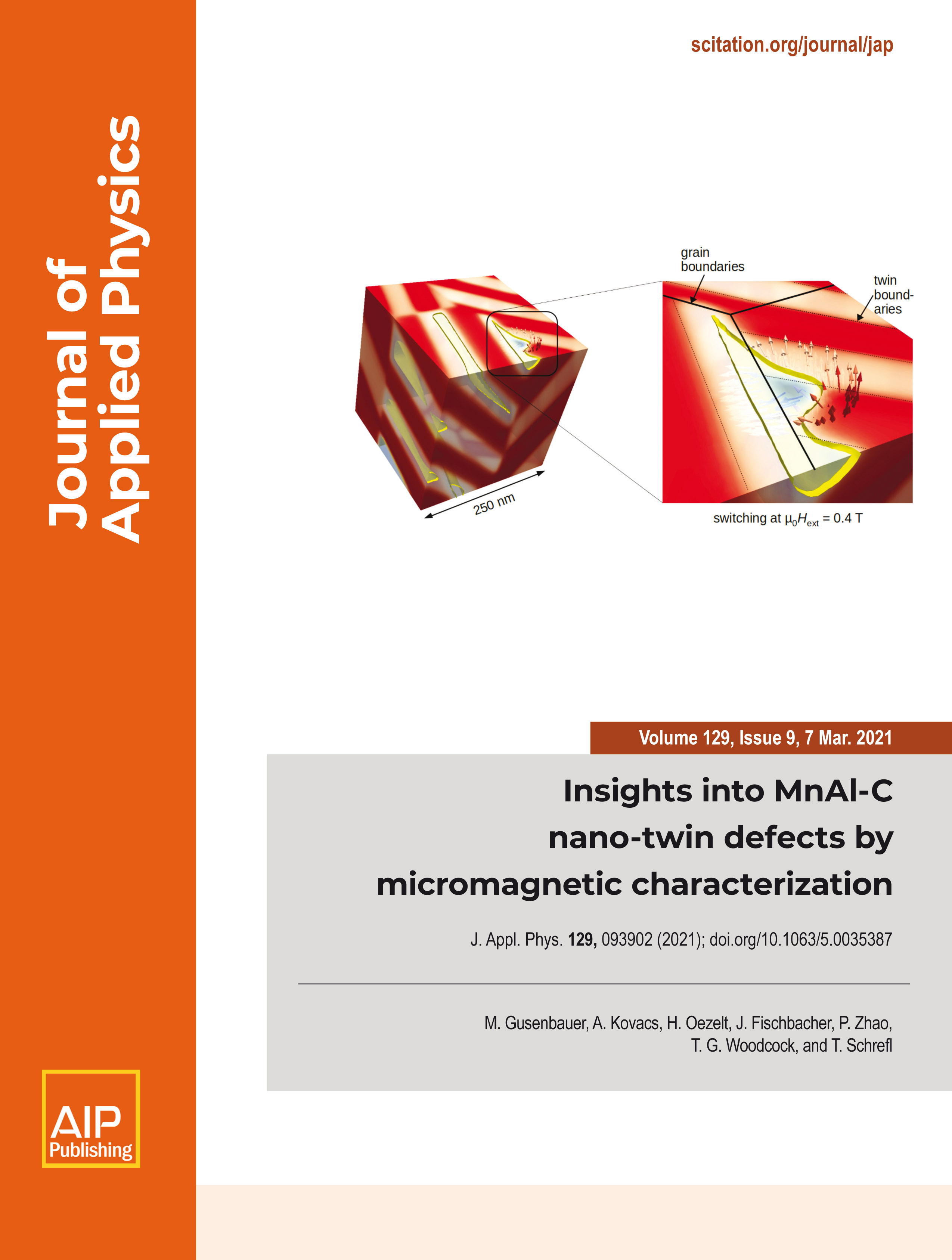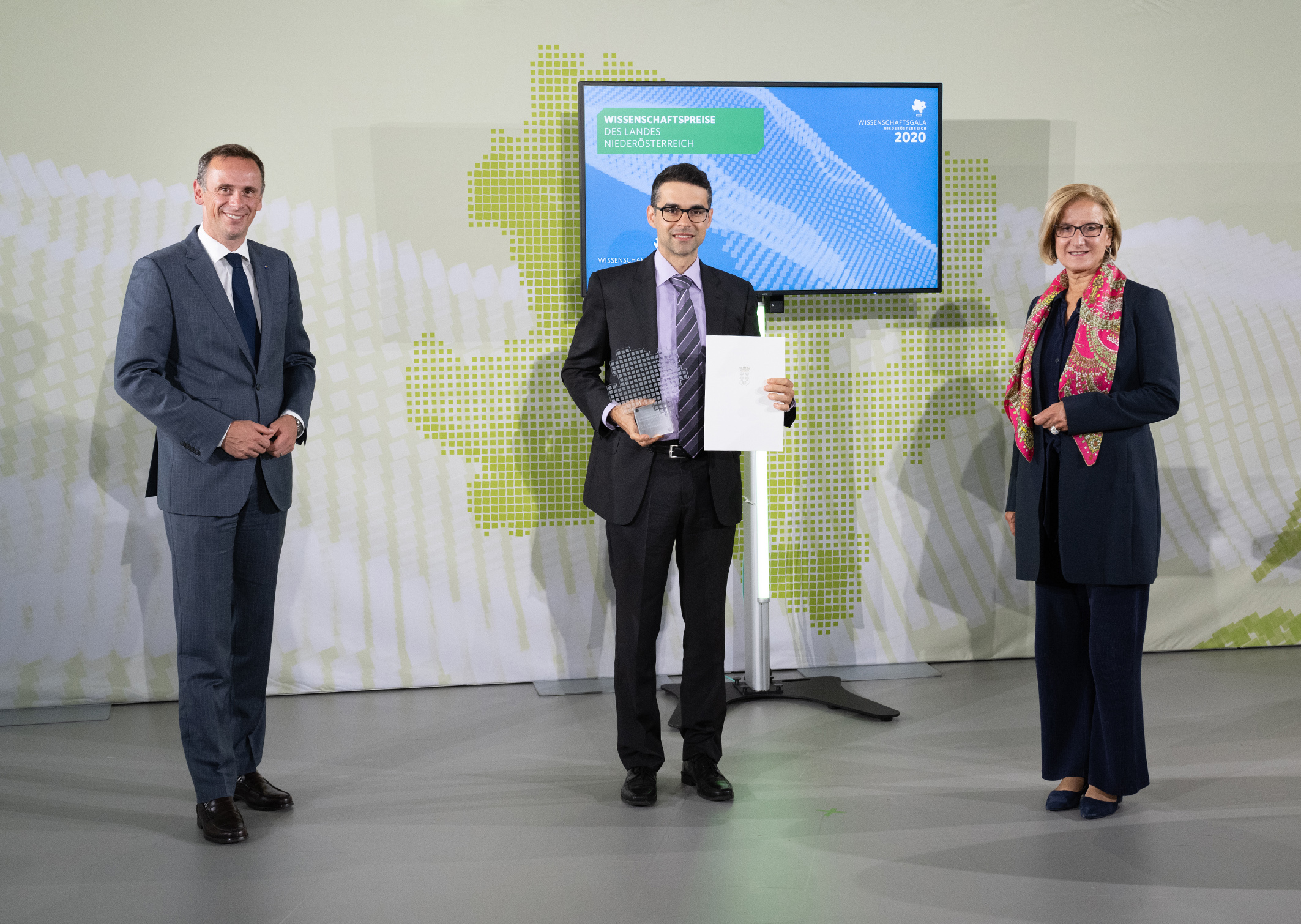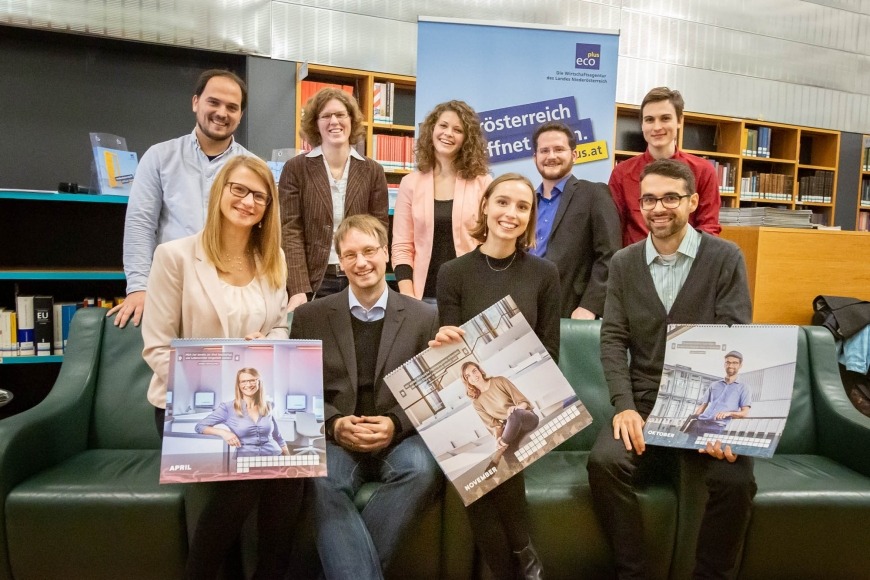Permanent magnets are key elements of modern society. Important application areas are energy conversion including eco-efficient transport, hydro- and wind power. A promising magnetic material is MnAl-C. Although it contains no ferromagnetic elements such as iron, nickel or cobalt, the so-called tau-MnAl-C is ferromagnetic up to high temperatures and has all properties which are prerequisites for high performance permanent magnets. The tau-MnAl-C contains no critical elements and therefore the long term use of this material is environmentally sustainable, in stark contrast to that of rare earth magnets such as Nd-Fe-B. In addition, tau-MnAl-C has a low physical density, which is a significant advantage for transport and aerospace applications.
In this project, a novel approach combining state of the art characterisation techniques with cutting edge computer simulations will be used to obtain quantitative information concerning the effect of interfaces on magnetisation reversal in tau-MnAl-C.
actual
We published the work: “ Insights into MnAl-C nano twin defects by micromagnetic characterization” in the Journal of Applied Physics. The paper has been featured on the cover as well as has been chosen by the publisher, AIP, for special publicity in the form of a science highlight known as a Scilight:
Larter, Raima. “Crystallographic defects strongly influence alloy’s magnetic properties”. AIP Scilight. 2021. DOI: 10.1063/10.0003702
l
Markus Gusenbauer was awarded with the “Anerkennungspreis” from the Lower Austrian annual recognition awards for special scientific achievements (https://www.noe.gv.at/noe/Wissenschaft-Forschung/wissenschaftspreise_noe.html, last visited on 2021-03-04). As an outcome several press articles and a follow-up article in the Chemiereport (https://www.chemiereport.at/epaper/201907/#64, last visited on 2021-03-04) have been published._NLK%20Pfeiffer.2021-03-09-11-13-05.jpg)
07.07.2020: The research results on extracting local nucleation fields in permanent magnets by machine learning were published in the Nature Partner Journal Computational Materials (https://doi.org/10.1038/s41524-020-00361-z). In addition, the successful project work was honored with an invited lecture at the congress: International Workshop on Rare-Earth and Future Permanent Magnets and their Applications (REPM2020, https://sites.udel.edu/repm2020/) in Baltimore.
Local nucleation fields: (a) ground truth, (b) prediction, (c) absolute deviation
An abstract has been submitted for the conference: Magnetism and Magnetic Materials Materials (MMM2020, https://magnetism.org/), which will take place in virtual form from 2 to 6 November 2020, originally planned in Florida.
„Macromagnetic Simulations by Micromagnetic Superposition
Micromagnetic simulations are typically limited to a few micrometers due to the high demand on computing resources. But in applications and experiments the specimen size is usually orders of magnitude larger. While the micromagnetic simulations reproduce trends nicely, the absolute value of the results differ from the experiments [1]. Often the size limitation in the simulations is the reason for this deviation. Normally this is overcome either by artificial scaling [2] or by a reduced-order model [3]. In this work we introduce a type of reduced-order model to bridge the length scale from micromagnetism to experiments. In contrast to the work of Blank [4], we also consider the microstructural features of the magnet. We subdivide the computation of a large sample, e.g. from experimental measurements, into multiple independent feasible-sized subsets. For each subset, the nucleation field is either calculated by micromagnetic simulation or predicted by a trained machine learning model [5] (Fig. 1). The subsets along with their microstructure and nucleation fields are fed into a newly developed python code to spatially reassemble the entire sample and compute the overall hysteresis (Fig. 2). To take the microstructure into account, each subset is further discretized in cubic elements with their own anisotropic easy axis. In each calculation step, the magnetostatic field and the exchange field of the entire sample is calculated based on the magnetic moments of these elements. The two field contributions and an increasing external field are summed up to a total field. Taking this total field into account, we compute the reversible rotations with the Stoner-Wohlfarth model and use the prestored nucleation fields to irreversibly switch the respective subset.
We gratefully acknowledge the financial support of the Austrian Science Fund (FWF), Project: I 3288-N36 and the German Research Foundation (DFG), Project: 326646134.
References:
[1] X. Tang, et al., Acta Mater. 144, 884-895 (2018)
[2] S. Bance, et al., Acta Mater. 131, 48-56 (2017)
[3] L. Exl, et al., J. Phys. Mater. 2, 014001 (2019)
[4] R. Blank, J. Magn. Magn. Mater. 101, 1-3, 317-322 (1991)
[5] M. Gusenbauer, et al., accepted npj Comput. Mater., (2020)”
On 12.05.2020 the project meeting planned in Krems took place online due to the travel stop caused by Corona. Important points for the successful completion of the project could be worked out. Furthermore, a publication in the Nature Partner Journal Computational Materials was finalized. The final topic was a joint project proposal for the continuation of the research cooperation. We agreed on a concept which, based on the previous knowledge of MnAl-C, will also allow the investigation of other magnetic materials.
On 01.10.2019 the next project meeting took place in Dresden. Participants were again Dr. Thomas G. Woodcock and Panpan Zhao from IFW Dresden, and Dr. Markus Gusenbauer, Dr. Thomas Schrefl and Harald Özelt from the Danube University Krems. We were able to get an up-to-date picture of the exact status of the project. Furthermore, some promising ideas were collected for a continuation of the cooperation after the end of the project in September 2020..
15.09.2019: A publication with the title: “Automated meshing of electron backscatter diffraction data and application to finite element micromagnetics” has been submitted to the Journal of Magnetism and Magnetic Materials (https://doi.org/10.1016/j.jmmm.2019.165256).
The Young Researchers’ Calendar 2019 was presented at the Lower Austrian State Library. Markus Gusenbauer was one of twelve people whose above-average achievements represent Lower Austria's technology locations.
"We must succeed in continuing to inspire as many young people as possible to careers in science and research. Lower Austria will need the brightest minds in the future as well. The young scientists in the Young Researchers' Calendar 2019 are the best role models here. With their impressive research topics, they are perfect flagships for Lower Austria as a research location," explained Petra Bohuslav, State Councillor for Economics and Technology.
jungforscherkalender_2019_web.pdf
https://www.noe.gv.at/noe/NOe_Jungforscher-Kalender_2019_praesentiert.html

On 20.09 2018 a project meeting took place in Krems. Participants were Dr. Thomas G. Woodcock and Panpan Zhao from IFW Dresden, and Dr. Markus Gusenbauer, Dr. Thomas Schrefl and Harald Özelt from the Danube University Krems. The exchange of previous research results was very informative to define the next project goals. A work plan for 3 joint publications was drawn up, which will be implemented in the next project year.
An abstract has been submitted to the Joint European Magnetic Symposia (JEMS) 2019 Conference, which will take place in Uppsala from 26 - 30 August 2019 (http://magnetism.eu/133-jems-2019.htm).
An abstract has been submitted to the Joint European Magnetic Symposia (JEMS) 2018 Conference, which will take place from September 3 - 7, 2018 in Mainz (https://jems2018.org).
„Automated micromagnetic simulations from native EBSD data
Micromagnetic simulations require a detailed knowledge of the crystallographic structure of the material. In permanent magnets with reduced or no rare-earth elements typically crystallographic features play an important role for the energy density product. In MnAl compounds twinning and antiphase boundaries are known to effect nucleation and pinning fields. Micromagnetic simulations can help to improve the understanding of these effects on the hysteresis properties.
In preliminary studies artificial microstructures have been used for the simulations. Here we take native Electron Backscatter Diffraction (EBSD) data of MnAl microstructures to automatically create high quality finite element meshes with adaptive mesh size. A fast micromagnetic solver, minimizing the Gibbs’ free energy, is applied subsequently and computes the hysteresis properties of the microscopic data.
The automated meshing and micromagnetic simulation routine is controlled via a Python script. Dream3D extracts EBSD data and converts them to a pixelated bitmap. Using image manipulation tools, the bitmap is automatically smoothed, corrected and upscaled. Iso2Mesh creates a 3D finite element mesh. An additional airbox, which is required for the stray field computation, is prepared with the Salome tool. The computed coercive fields are in the range of 0.36 T/μ0 to 0.53 T/μ0 depending on the density of defects.”
Our project partners in Dresden have submitted an abstract to the Materials Science and Engineering Congress - MSE 2018, which will take place from September 26 - 28 in Darmstadt (http://www.mse-congress.de/).
“The Interaction of Twin Boundaries with Magnetic Domain Walls in MnAl-C Studied by Combined EBSD and Micromagnetic Modelling Techniques
The microstructure of MnAl-C is characterized by the presence of three different twin-like defects (pseudo twins, order twins, and true twins). Combined EBSD characterization and micromagnetic modelling has shown that the twin boundaries interact with magnetic domain walls and thus influence the magnetic properties of the material. This interaction is of great interest as the measured magnetic properties of MnAl-C are currently insufficient for the application of the material as a permanent magnet. Until now, only the twin boundary misorientation has been considered; however, a further two macroscopic degrees of freedom, giving the crystallographic orientation of the boundary plane, are required for a full description of the boundary. Various EBSD-based methods to obtain these two parameters for large numbers of boundaries are being explored in order to make the connection between the magnetic properties and the distribution of the twin boundary plane normal for the first time. Based on the results of microstructural characterization, finite element micromagnetic models are applied to investigate the interaction of domain walls and twin-like defect boundary. Through the simulation, the critical nucleation and depinning fields across these three crystallographically different twin-like defect boundaries are calculated, as well as the macroscopic magnetization profile.”
The first kick-off meeting took place in Dresden on 15 February 2018. Participants were Dr. Thomas G. Woodcock and Panpan Zhao from IFW Dresden, and Dr. Markus Gusenbauer and Dr. Thomas Schrefl from the Danube University Krems. The day was used extremely productively with status reports from the respective project partners, laboratory tour of the Institute for Metallic Materials, brainstorming to achieve the project goals and a detailed division of work for the coming project months.
On the 3rd and 4th of May 2017 the FWF Roadshow took place at Campus Krems. The information event of the FWF started with high-level discussions of the associated institutions on the campus. A presentation by the FWF and small group consultations were followed by a poster presentation and Speed Talks by FWF-funded scientists. Dr. Markus Gusenbauer spoke about the project "The Effect of Interfaces on Magnetisation Reversal in MnAl-C".
@ Details:
Projekt partner:
Thomas G. Woodcock,
IFW Dresden, Institute for Metallic Materials
http://www.ifw-dresden.de/institutes/imw/research/magnetic-materials/
Funding:
FWF, Project: I 3288-N36
Details
| Duration | 01/10/2017 - 30/11/2020 |
|---|---|
| Funding | FWF |
| Program | DACH |
| Department | |
| Principle investigator for the project (University for Continuing Education Krems) | Dipl.-Ing.(FH) Dr. Markus Gusenbauer |
Publications
Gusenbauer, M.; Kovacs, A.; Özelt, H.; Fischbacher, J.; Zhao, P.; Woodcock, T.G.;Schrefl, T. (2021). Insights into MnAl-C nano-twin defects by micromagnetic characterization. Journal of Applied Physics, 129(9): 093902
Gusenbauer, G.; Oezelt, H.; Fischbacher, J.; Kovacs, A.; Zhao, P.; Woodcock, T. G.; Schrefl, T. (2020). Extracting local switching fields in permanent magnets using machine learning. npj Computational Materials, 6: 89ff
Arapan, S.; Nieves, P.; Cuesta-López, S.; Gusenbauer, M.; Oezelt, H.; Schrefl, T.; Delczeg-Czirjak, E. K.; Herper, H. C.; Eriksson, O. (2019). Influence of antiphase boundary of the MnAl t-phase on the energy product. Physical Review Materials, Vol. 3, iss. 6: 064412
Gusenbauer, M.; Fischbacher, J.; Kovacs, A.; Oezelt, H.; Bance, S.; Zhao, P.; Woodcock, T.G.; Schrefl, T. (2019). Automated meshing of electron backscatter diffraction data and application to finite element micromagnetics. Journal of Magnetism and Magnetic Materials, Volume 486: 165256
Lectures
Machine Learning for Relating Structure and Coercivity of Permanent Magnets
Virtual REPM 2021, 09/06/2021
Bridging the gap between biomedical applications and material sciences
3rd Workshop on Modelling of Biological Cells, Fluid Flow and Microfluidics, 11/02/2020
Micromagnetic characterization of MnAl-C using trained neural networks
JEMS2019, Uppsala, Schweden, 29/08/2019
Automated micromagnetic simulations from Electron Backscatter Diffraction data
JEMS 2018, 05/09/2018

